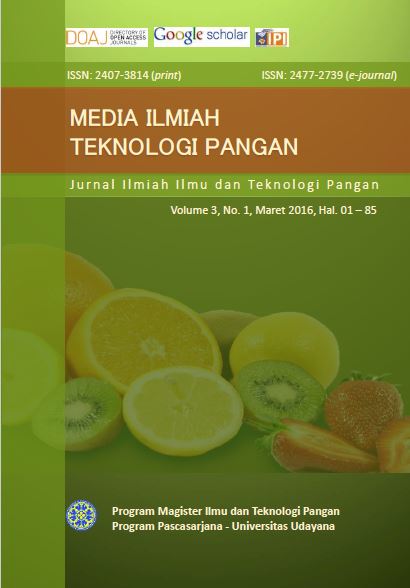Characteristic of bioplastic’s physical and mechanical (Study on Tapioca Concentration and Composition Mixture of Plasticizer)
Abstract
This study aims to (1) the effect of the concentration of starch and ratio mixture of plasticizer to the physical and mechanical characteristics of bioplastics (2) determine the concentration of starch and plasticizer RATIO mixture that results in physical and mechanical characteristics of bio plastics best. The experiment was conducted using a factorial randomized block design. The first factor is the concentration of tapioca consisting of 3 levels 4%, 5% and 6% (w / w). The second factor is the mixture plasticizer ratio of glycerol and sorbitol consisting of 5 levels ie (100: 0)%, (95: 5)%, (90:10)%, (85:15)%, (80:20)% b / b. Each combination of treatments classified into 2 time processing bio plastics, so there are 30 experimental units. Variables observed water content, elongation at break, tensile strength and Young's modulus . The data obtained were analyzed of variant and test of Duncan's.
The results showed that the concentration of tapioca and mixture plasticizer had no effect on water content but significant effect on the elongation at break, tensile strength and Young's modulus. The concentration of starch 6% with a ratio of mixture of plasticizers glycerol: sorbitol ( 100: 0) produces the best characteristics of bioplastics with water content of 3.98%, elongation at break of 18.75%, the tensile strength of 930 MPa and a Young's modulus of 50 MPa.
Downloads
References
Averous, L., (2004) Biodegradable Multiphase System Based on Plasticized Starch : A Review, Journal of Macromolecular Science, United Kingdom.
Darni, Y., Chici A., Sri Ismiyati D. (2008) Sintesa Bioplastik dari Pati Pisang dan Gelatin dengan Plasticizer Gliserol. Prosiding Seminar Nasional Sains dan Teknologi-II 2008 Lampung: Universitas Lampung.
Firdaus, F., dan Anwar, C. (2014) Potensi Limbah Padat Cair Industri Tepung Tapioka Sebagai Bahan Baku Film Plastik Biodegradable. Jurnal Logika Volume I No 2, 2014
Kumoro, A. C. dan Purbasari, A. (2014) Sifat Mekanik Dan Morfologi Plastik Biodegradable Dari Limbah Tepung Nasi Aking Dan Tepung Tapioka Menggunakan Gliserol Sebagai Plasticizer. Jurnal Teknik Kimia ISSN 0852-1697, Universitas Diponegoro
Liu, Z.and Han, J.H.(2005), Film Forming Characteristics of Starches, J. Food Science, Vol. 70, No. 1, E31-E36.
Romadloniyah, F. (2012) Pembuatan Dan Karakterisasi Plastik Biodegradable dari Onggok Singkong dengan Plasticizer Sorbitol. Fakultas Sains dan Teknologi, Universitas Islam Negeri Sunan Kalijaga. Yogyakarta
Setiani, W., Sudiarti, T., Rahmidar. L. (2013) Preparasi dan karakterisitk edible film dari poliblend pati sukun-kitosan. J. Valensi, 3(2): 100-109








